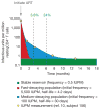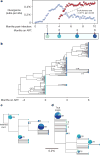Re-evaluating evolution in the HIV reservoir
- PMID: 29168805
- PMCID: PMC6103791
- DOI: 10.1038/nature24634
Re-evaluating evolution in the HIV reservoir
Conflict of interest statement
Figures


Similar articles
-
Genetically Intact but Functionally Impaired HIV-1 Env Glycoproteins in the T-Cell Reservoir.J Virol. 2018 Jan 30;92(4):e01684-17. doi: 10.1128/JVI.01684-17. Print 2018 Feb 15. J Virol. 2018. PMID: 29187544 Free PMC article.
-
The lymphocyte HIV reservoir in patients on long-term HAART is a memory of virus evolution.AIDS. 2004 May 21;18(8):1147-58. doi: 10.1097/00002030-200405210-00008. AIDS. 2004. PMID: 15166530
-
A long-term latent reservoir for HIV-1: discovery and clinical implications.J Antimicrob Chemother. 2004 Jul;54(1):6-9. doi: 10.1093/jac/dkh292. Epub 2004 May 26. J Antimicrob Chemother. 2004. PMID: 15163657 Review.
-
Scientific rationale for antiretroviral therapy in 2005: viral reservoirs and resistance evolution.Top HIV Med. 2005 Aug-Sep;13(3):96-100. Top HIV Med. 2005. PMID: 16170226
-
The Alphabet Soup of HIV Reservoir Markers.Curr HIV/AIDS Rep. 2017 Apr;14(2):72-81. doi: 10.1007/s11904-017-0355-y. Curr HIV/AIDS Rep. 2017. PMID: 28401492 Free PMC article. Review.
Cited by
-
Cell-Associated HIV-1 Unspliced-to-Multiply-Spliced RNA Ratio at 12 Weeks of ART Predicts Immune Reconstitution on Therapy.mBio. 2021 Mar 9;12(2):e00099-21. doi: 10.1128/mBio.00099-21. mBio. 2021. PMID: 33688002 Free PMC article.
-
Recent progress in understanding HIV reservoirs.Curr Opin HIV AIDS. 2018 Mar;13(2):137-142. doi: 10.1097/COH.0000000000000441. Curr Opin HIV AIDS. 2018. PMID: 29232209 Free PMC article. Review.
-
Systemic HIV and SIV latency reversal via non-canonical NF-κB signalling in vivo.Nature. 2020 Feb;578(7793):160-165. doi: 10.1038/s41586-020-1951-3. Epub 2020 Jan 22. Nature. 2020. PMID: 31969707 Free PMC article.
-
Applications and limitations of the passenger hypothesis for HIV reservoir persistence and cure.J Virol. 2025 Jul 22;99(7):e0071425. doi: 10.1128/jvi.00714-25. Epub 2025 Jun 4. J Virol. 2025. PMID: 40464563 Free PMC article. Review.
-
Plasma Indoleamine 2,3-Dioxygenase Activity Is Associated With the Size of the Human Immunodeficiency Virus Reservoir in Patients Receiving Antiretroviral Therapy.Clin Infect Dis. 2019 Apr 8;68(8):1274-1281. doi: 10.1093/cid/ciy676. Clin Infect Dis. 2019. PMID: 30107503 Free PMC article.
References
-
- Chun TW, et al. Quantification of latent tissue reservoirs and total body viral load in HIV-1 infection. Nature. 1997;387:183–188. - PubMed
-
- Finzi D, et al. Identification of a reservoir for HIV-1 in patients on highly active antiretroviral therapy. Science. 1997;278:1295–1300. - PubMed
-
- Wong JK, et al. Recovery of replication-competent HIV despite prolonged suppression of plasma viremia. Science. 1997;278:1291–1295. - PubMed
-
- Finzi D, et al. Latent infection of CD4+ T cells provides a mechanism for lifelong persistence of HIV-1, even in patients on effective combination therapy. Nat Med. 1999;5:512–517. - PubMed
Grants and funding
LinkOut - more resources
Full Text Sources
Other Literature Sources

